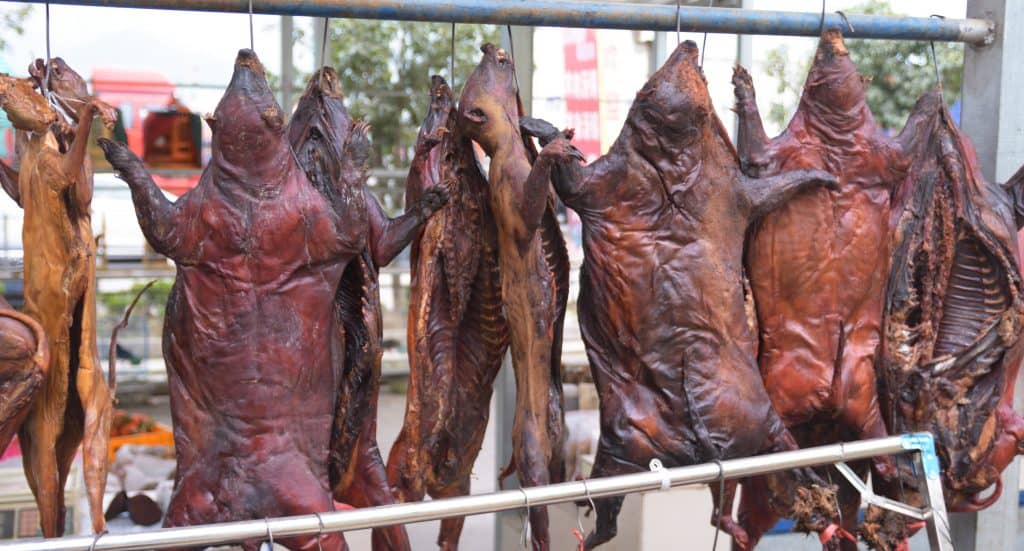by Richard Schulman

China wet markets have repeatedly caused global epidemics, including the latest Wuhan coronavirus pandemic. The viruses jump from one species to another — bats, snakes, pangolins, chickens — and then to humans. Wet markets, where wild animals alive and dead are sold, exist elsewhere in the world, but China’s are unique in featuring hundreds of different species, bred both locally in China and imported from around the world. The Chinese wet markets also illegally sell endangered species.
Most Chinese don’t consume wild animals from the wet markets. They’re basically a luxury product consumed by country’s rich and powerful, who believe the products will improve their health, build their muscles, or increase their sexual desire and potency. None of these beliefs have any scientific validity. But the Beijing regime does not wish to alienate this constituency, whose happiness and good regard the regime considers important to its continued rule.
One, two, many epidemics
The following global epidemics in recent years have all been traced to China wet markets:
- The 1997 bird (avian) flu, traced to Hong Kong’s live poultry market;
- The 2002-2003 SARS epidemic started in a wet market in Foshan, Gwangdong province, China. It is believed to have jumped from civet cats to humans, with bats possibly having infected the civet cats. There were a reported 774 fatalities;
- The 2013-2017 influenza virus, about which seven China-based scientists comment, in Trends in Microbiology: “H7N9 influenza viruses were first isolated in 2013 and continue to cause human infections. H7N9 infections represent an ongoing public health threat that has resulted in 1344 cases with 511 deaths as of April 9, 2017. This highlights the continued threat posed by the current poultry trade and live poultry market system in China.”
- Hantavirus [Hemorrhagic fever with renal syndrome (HFRS)] has been endemic in China for at least a millenium. It is spread by rat-human transmission. Rats and baby mice are eaten as a delicacy in many parts of China and therefore sold in wet markets. Three scientists wrote the following in Emerging Infectious Diseases (2010): “HFRS-like disease was described in Chinese writings ≈1,000 years ago. Then in the early 1930s, HFRS cases among Japanese soldiers in northeastern China were reported. Subsequently, HFRS cases have been reported each year in China, >30,000 cases during 1931–1949.” “Hemorrhagic fever with renal syndrome (HFRS) is a serious public health problem in the People’s Republic of China….During 1950–2007, a total of 1,557,622 cases of HFRS in humans and 46,427 deaths (3%) were reported in China. HFRS has been reported in 29 of 31 provinces in China. After implementation of comprehensive preventive measures, including vaccination, in the past decade in China, incidence of HFRS has dramatically decreased; only 11,248 HFRS cases were reported in 2007…. However, the numbers of HFRS cases and deaths in China remain the highest in the world…. Transmission among rodents and from rodents to humans generally occurs through inhalation of aerosolized excreta.”
Wet markets are a perfect environment for the “inhalation of aerosolized excreta.” University of Houston scientist Peter Li, an expert on China’s food markets, comments in a Vox video:
The cages are stacked one over the other. Animals at the bottom are often soaked with all kinds of liquids, animal excrement, pus, blood — whatever the liquid they are receiving from the animals above.
“That’s exactly how a virus can jump from one animal to another,” the Vox narrator adds.
Xi Jinping delay, censorship created today’s pandemic
Xi Jinping ordered his sycophantic party followers to keep the public ignorant about the spreading Wuhan virus until it became too late to stop it from becoming a pandemic. China’s government is now in desperation circulating the lie that the US military might have brought the virus to China.
The US, one of the many victims of Chinese dictator Xi Jinping’s malfeasance, is now moving to implement the successful approach pioneered by the city-state of Singapore — by adapting it to the much larger, more decentralized federal / state / local / private-sector division of power in this country.
Despite some initial missteps, the US seems to be doing a better job than Europe. Italy has not found in the European Union a friend in time of need, and the UK’s government-run National Health Service (NHS) is discussing denying the weakest patients — i.e., the elderly — the intensive care without which they will die.
Some welcome signs of bipartisanship
Anthony Fauci, head of the National Institute of Allergy and Infectious Diseases (NIAID) at the National Institutes of Health (NIH) — widely respected by both Democrats and Republicans — strongly defends President Trump’s one-month travel ban on Europeans coming to the US. The reason, Dr. Fauci told a House committee hearing last Thursday, is that 70% of the new coronavirus cases appearing recently in the US trace back to European sources of infection. Similarly, California’s Governor Newsom praised the close cooperation he’d received from President Trump regarding the cruise ship near San Francisco with 21 passengers infected with the virus.
So too, in 2012, NJ governor Christie, despite widespread Republican criticism, strongly praised President Obama for his generous help to his state in the aftermath of Hurricane Sandy.
Hat tip: For the article and embedded video “Why new diseases keep appearing in China” by Sam Ellis, Vox, Mar 6, 2020.

Leave a Reply